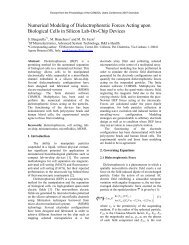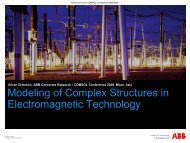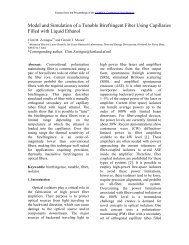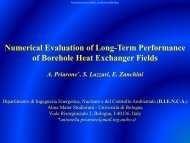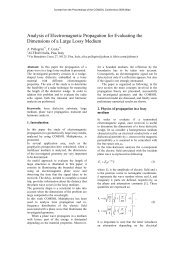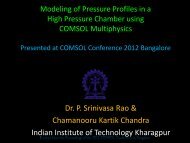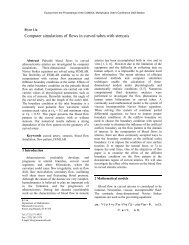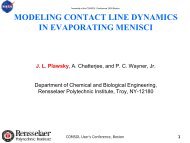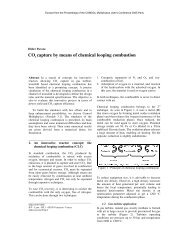Two Dimensional FEM Simulation of Ultrasonic ... - COMSOL.com
Two Dimensional FEM Simulation of Ultrasonic ... - COMSOL.com
Two Dimensional FEM Simulation of Ultrasonic ... - COMSOL.com
Create successful ePaper yourself
Turn your PDF publications into a flip-book with our unique Google optimized e-Paper software.
Presented at the <strong>COMSOL</strong> Conference 2010 India<strong>Two</strong> <strong>Dimensional</strong> <strong>FEM</strong><strong>Simulation</strong> <strong>of</strong> <strong>Ultrasonic</strong> WavePropagation in Isotropic SolidMedia Using <strong>COMSOL</strong> ®Bikash Ghose 1 * , Krishnan Balasubramaniam 2 #C V Krishnamurthy 3 , A Subhananda Rao 11 High Energy Materials Research Laboratory, Sutarwadi, Pune - 212 Center for Non Destructive Evaluation, IIT Madras, Chennai - 363 Department <strong>of</strong> Physics, IIT Madras, Chennai -36E-mail: * ghose.bikash@hemrl.drdo.in , # balas@iitm.ac.in
Motivation Application <strong>of</strong> <strong>Ultrasonic</strong> wave propagation• Under Water Acoustics• Medical Diagnostic• Structural Health Monitoring (SHM)• Non-Destructive Evaluation (NDE)• Material Characterization Non-Destructive Evaluation• Bulk wave Longitudinal wave (Pulse echo technique, Throughtransmission etc) Transverse Wave• Surface Wave• Guided Wave / Lamb Wave etc. Guided Wave• Many different modes <strong>of</strong> ultrasonic vibration(Symmetric, Anti symmetric) Numerical <strong>Simulation</strong> <strong>of</strong> Wave propagation• Fluid (Only Longitudinal wave)• Solid (Longitudinal, Transverse, Surface, Lambetc) Use <strong>of</strong> <strong>COMSOL</strong> for simulation <strong>of</strong> wavepropagation in solids
Transient Analysis for WavePropagation Transient Analysis always pose difficult problems Length <strong>of</strong> element (∆x)( Time steps (∆t)( Type <strong>of</strong> Elements (Triangular, Quad) Integration scheme for integration over time Issues• Instability• Numerical Dispersion• Convergence
Numerical <strong>Simulation</strong> <strong>of</strong> <strong>Ultrasonic</strong>Wave Propagation using <strong>COMSOL</strong> ®Thumb Rule ?•Length <strong>of</strong>Element (∆x) = λ/12•Time Step = ∆x/C phInitial DisplacementDisplacement at diff positions with timeSolution at 7.0×10 -5 sSolution at 1.7×10 -4 s
Materials & <strong>Ultrasonic</strong> WaveProperties Young’s s Modulus (E) = 2 × 10 11 Pa Poisson’s s ratio (ν)() = 0.33 Density (ρ)() = 7850 kg/m3 <strong>Ultrasonic</strong> velocity (C L) (longitudinalwave) = 5850 m/s Frequency <strong>of</strong> incident ultrasonic wave (f)(= 20 kHz = 20×103 s -1 Wavelength <strong>of</strong> the longitudinal ultrasonicwave (λ(L) = C L/f = 0.2925 m Source Length : 0.04 m (40 mm)(located at the middle) Source Excitation : On a line and pointson line <strong>Simulation</strong> Domain : 5.0 m (L) x 2.5 m(H)D isplac em ent (m )6420-2-4-6-8-100 0.5 1 1.58 x Time (s)x 10 -4|Y(f)|54.543.532.521.510.5x 10 -7Single-Sided Amplitude Spectrum <strong>of</strong> y(t)(Hanning windowed signal)0 2 4 6 8 10 12 14 16 18 20Frequency (Hz)x 10 4
Meshing and Application Modes Triangular Elements Elements AutomaticallyGenerated Approximation : Plane Stain Element Type : LagrangeQuadratic Analysis : Transient Solver : Time Dependent
Effect <strong>of</strong> Length <strong>of</strong> Element (∆x)(As per CFL Criteria∆tcritical=∆xCph∆xCmax max0 −6= = = 3.1×10L.0182m5850m/ ssThe time steps chosen initially for simulation for different ∆x maxis2.5×10 -6 s
Onward Propagating Wave at variousDistances for Different λ L /∆x max at t = 4×104-4 sDisplacements (m)1.00E-078.00E-086.00E-084.00E-082.00E-080.00E+000-2.00E-080.0001 0.0002 0.0003 0.0004 0.0005-4.00E-08-6.00E-08At 0.3 mRatio = 2Ratio = 3Ratio = 4Ratio= 5Ratio = 8Ratio = 9Ratio = 12Ratio = 16Displacement (m)6.00E-084.00E-082.00E-08-2.00E-08-4.00E-08At 0.5 mRatio = 2Ratio = 3Ratio = 4Ratio = 5Ratio = 8Ratio = 9Ratio = 12Ratio = 160.00E+000 0.0001 0.0002 0.0003 0.0004 0.0005Displacement (m)-8.00E-085.00E-084.00E-083.00E-082.00E-081.00E-08Time (s)At 0.8 mRatio = 2Ratio = 3Ratio = 4Ratio = 5Ratio = 8Ratio = 9Ratio = 12Ratio = 160.00E+000 0.0001 0.0002 0.0003 0.0004 0.0005-1.00E-08Displacement-6.00E-084.00E-083.00E-082.00E-081.00E-08Time (t)At 1.0 mRatio = 2Ratio = 3Ratio = 4Ratio = 5Ratio = 8Ratio = 9Ratio = 12Ratio = 160.00E+000 0.00005 0.0001 0.00015 0.0002 0.00025 0.0003 0.00035 0.0004 0.00045-1.00E-08-2.00E-08-3.00E-08-4.00E-08-5.00E-08Time (s)• Oscillations remains after passing by <strong>of</strong> signal• Convergence <strong>of</strong> the solution for the ratio (λ L/∆x max) ≥ 8• Time steps are taken from solver or exactly what has beengiven does not make any difference to the propagating signal-2.00E-08-3.00E-08-4.00E-08Time (t)
Onward Propagating Wave for Differentλ L /∆x max at t = 4×104-4 sDisplacement (m)2.50E-082.00E-081.50E-081.00E-085.00E-090.00E+00-5.00E-09-1.00E-08Ratio = 2Ratio = 3ratio = 4ratio = 5Ratio = 8Ratio = 9Ratio = 120 0.5 1 1.5 2 2.5 3-1.50E-08-2.00E-08-2.50E-08Distance from Source center (m)Line pr<strong>of</strong>ile (Displacement Vs Distance from source) at0.0004s for different wavelength to element length ratio
Effect <strong>of</strong> Time Steps (∆t)( As per CFL criteria the time steps should be less than ∆x/Cx/C Lfor example, for the maximum element length <strong>of</strong> λ L /10 thetime steps should be ≤ (λ L /10×C L ) that means if Signal so far obtained is not as expected Major change in the shape <strong>of</strong> signal Time steps further decreased and solution was checked forconvergenceλL∆xmax=10∆x⇒ ∆t≤C⇒ ∆tmaxL1≤10×fλL=10×CL
∆t= 10×10Case: I λ L /∆xmax= = 5−6s∆t= 5×10−6s∆t= 2.0×10−6s∆t= 1.0×10−6s∆t=0.5×10−6s∆t= 0.2×10−6s
∆t= 6.26×10Case: II λ L /∆xmax= = 8−6s∆t= 5×10−6s∆t= 2.0×10−6s∆t= 1.0×10−6s∆t=0.5×10−6s∆t= 0.2×10−6s
Case: III λ L /∆xmax= = 12∆t= 5×10−6s∆t= 2.5×10−6s∆t= 1.0×10−6s∆t=0.5×10−6s
Effect <strong>of</strong> Excitation on Line and Points onLine for λ L /∆x max = 8 and ∆t t = 2.5x10 -6 s(Line source)At 1.0 m(Points on Line source)At 1.0 mAt 0.5 mAt 0.5 m
Effect <strong>of</strong> Excitation on Line and Points onLine for λ L /∆x max = 8 and ∆t t = 2.5x10 -6 sLine pr<strong>of</strong>ile at t = 4x10 -4 s(Line source)(Points on Line source)
Time and Frequency Domain Signal forForward Propagating Waveλ L∆xmax= 12λ L∆xmax= 8λ L∆xmax= 58.00E-088.00E-088.00E-084.00E-084.00E-084.00E-08D isplacem ent (m )0.00E+000.00E+00 2.00E-04 4.00E-04 6.00E-04-4.00E-08Displacement (m)0.00E+000.00E+00 2.00E-04 4.00E-04 6.00E-04-4.00E-08Displacement (m)0.00E+000.00E+00 2.00E-04 4.00E-04 6.00E-04-4.00E-08-8.00E-08-8.00E-08-8.00E-08-1.20E-07Time (s)-1.20E-07Time (s)-1.20E-07Time (s)Single-Sided Amplitude Spectrumx 10-910Single-Sided Amplitude Spectrumx 10-914x 10 -9Single-Sided Amplitude Spectrum98121271010|Y (f)|654|Y(f)|86|Y (f)|86321424201 2 3 4 5 6 7 8 9Frequency (Hz)x 10 41 2 3 4 5 6 7 8 9Frequency (Hz)x 10 41 2 3 4 5 6 7 8 9Frequency (Hz)x 10 4All signals are for ∆t t =0.5x10 - 6 s
Time and Frequency Domain Signal forBack Wall Reflected Waveλ L∆xmax= 12λ L∆xmax= 8λ L∆xmax= 54.00E-084.00E-084.00E-082.00E-082.00E-082.00E-08Displacement (m)0.00E+000.00E+00 4.00E-04 8.00E-04 1.20E-03-2.00E-08Displacement (m)0.00E+000.00E+00 4.00E-04 8.00E-04 1.20E-03-2.00E-08D isplacem ent (m )0.00E+000.00E+00 4.00E-04 8.00E-04 1.20E-03-2.00E-08-4.00E-08-4.00E-08-4.00E-08-6.00E-08Time (s)-6.00E-08Time (s)-6.00E-08Time (s)Single-Sided Amplitude Spectrumx 10-97Single-Sided Amplitude Spectrumx 10-98x 10 -98Single-Sided Amplitude Spectrum677566|Y(f)|43|Y(f)|543|Y(f)|5432221110 1 2 3 4 5 6 7 8 9Frequency (Hz)x 10 41 2 3 4 5 6 7 8 9Frequency (Hz)x 10 41 2 3 4 5 6 7 8 9Frequency (Hz)x 10 4All signals are for ∆t t =0.5x10 - 6 s
<strong>Simulation</strong> Results for λ L /∆x max = 8∆t t = 0.5 x 10 -6 s at different timeAt t = 1x10 - 4 s
<strong>Simulation</strong> Results for λ L /∆x max = 8∆t t = 0.5 x 10 -6 s at different timeAt t = 4x10 - 4 s
<strong>Simulation</strong> Results for λ L /∆x max = 8∆t t = 0.5 x 10 -6 s at different timeAt t = 5x10 - 4 s
<strong>Simulation</strong> Results for λ L /∆x max = 8∆t t = 0.5 x 10 -6 s at different timeAt t = 8x10 - 4 s
Conclusions Wave Propagation can well be modeled using<strong>COMSOL</strong> with excitation on line segment and / oron points on line (Difference only in themaximum displacements) λ L /∆x max ≥ 8 irrespective <strong>of</strong> any time steps lessthan calculated by CFL criteria ( For triangularfree meshing) Time step ∆t should be about T/100 even if λ L /∆x≈ 16 No substantial difference in frequency content <strong>of</strong>forward as well as back wall reflected ultrasonicsignal observed
E-mail:ghose.bikash@hemrl.drdo.in , balas@iitm.ac.in


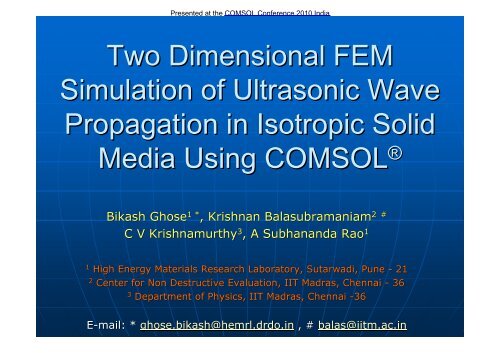
![[PDF] Microsoft Word - paper.docx - COMSOL.com](https://img.yumpu.com/50367802/1/184x260/pdf-microsoft-word-paperdocx-comsolcom.jpg?quality=85)
